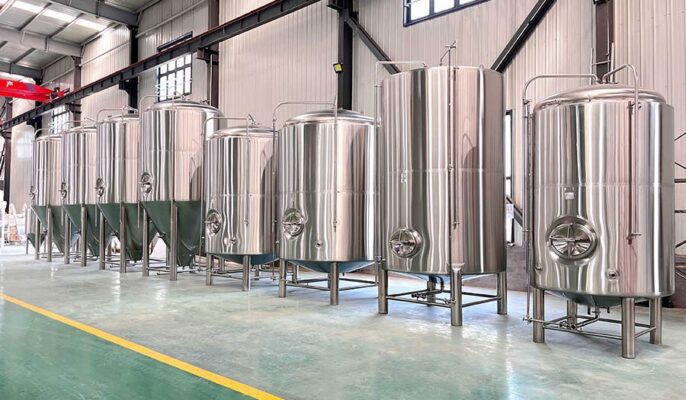Ongeacht de grootte van het proces, vereist het proces van het brouwen van lagers, ales, stouts en IPA's een zorgvuldig ontwerp en een gistingsatmosfeer. De gistingsfase is bijzonder belangrijk voor het resultaat van het mengsel en het koelen van het mengsel met behulp van een externe koeleenheid voor het deksel van de brouwerijgistingsinstallatie is een zeer effectieve manier om de gistingstemperaturen op een optimaal niveau te houden. Om te voorkomen dat het gistingsmengsel wordt blootgesteld aan ongewenste temperatuurniveaus, proberen brouwers vaak het proces te koelen. Voor brouwerijen die op grote schaal dranken produceren, is de meest effectieve manier om een optimale temperatuurregeling te garanderen het gebruik van een gistingskoelmantel in combinatie met een brouwerijkoelmachine of een glycolkoelmachine voor wijn.
Wat is een mantelfermentor?
Honingraatversterkte plaat is een plaat gemaakt van twee roestvrijstalen platen die gestanst zijn en aan beide zijden van een dikker honingraatkernmateriaal gelijmd zijn. Ook wel honingraat sandwichstructuur genoemd. Het heeft de eigenschappen van licht gewicht, goede geluidsisolatie en goede elasticiteit.
Koelmantels voor fermentoren/wijntanks zijn een temperatuurregeltechniek die bier van buitenaf koelt. Standaard koelmantels voor tanks zijn gemaakt van flexibel materiaal met holtes waar koelvloeistof (meestal een mengsel van glycol en water) doorheen stroomt. Wanneer een glycol jacket rond een wijnmakerij- of brouwerijvat wordt gewikkeld, absorbeert het de warmte binnenin.

Hoe werkt een koelmantel voor fermentoren?
De koelmantel van de fermentor bestaat uit flexibel materiaal waarin de koelkanalen lopen. Wanneer de koelmantel rond een brouwvat wordt gewikkeld, zal de koelvloeistof die in de kanalen van de mantel stroomt, warmte absorberen van de brouwvloeistof via een eenvoudig warmtewisselingsproces.
Voordeel:
- instelbare temperatuurniveaus voor gelijkmatiger koeling en fermentatie
- Onopzettelijke verontreiniging wordt voorkomen omdat de integriteit van de tank niet wordt aangetast
- Eenvoudig te installeren en onderhouden
De fermentatietank De koelmantel is een integraal onderdeel van de hele brouwerijkoeleenheid. Industriële koelers koelen de verwarmde koelvloeistof die terugkeert van de koelmantel van de tank opnieuw af en bereiden deze voor op recirculatie. De koelmachine houdt de koelvloeistof op de optimale vergistingstemperatuur voor wijn of bier.
Geschikte temperatuur
Elke giststam heeft zijn eigen voorkeurstemperatuur om de hoogste kwaliteit opbrengst te produceren. Saccharomyces cerevisiae (de meest voorkomende giststam) geeft bijvoorbeeld de voorkeur aan werktemperaturen van 30° C tot 45° C. Als het warmer of kouder is, is de productiviteit lager. Alles wat warmer of kouder is, remt de productiviteit. Om optimale productietijden en opbrengsten te behouden, is het beheren van de fermentatietemperatuur dus essentieel.
Koelmantel op fermentatietank
Een koelmantel op een fermentor werkt als een tank die rond de binnenwanden van het fermentatievat zit. Er zijn in- en uitlaten die het koelmedium door de mantel laten circuleren. Het debiet van het koelmedium kan worden gebruikt om de temperatuur van de fermentatie te regelen. Een jacket is dus een warmtewisselaar die warmte overdraagt tussen twee vloeistoffen. De ene vloeistof is ons koelmedium en de andere vloeistof is ons gistende bier of wijn.
Het belang van temperatuurgecontroleerde fermentatietanks
Het brouwen van het perfect smakende bier vereist verschillende factoren. Een van de belangrijkste factoren is het handhaven van de ideale temperatuur tijdens de fermentatie. Maar het is zeker belangrijk om de temperatuur hoog te houden, want als het wort te heet wordt, kan je bier fruitig smaken. Als je fermentor koeler is dan gewenst, kan het zijn dat het niet fermenteert, wat de kwaliteit en smaak beïnvloedt. Typische wijngistingstemperaturen variëren van 40 graden Fahrenheit tot 80 graden Fahrenheit. Het is vaak moeilijk om de brouwomstandigheden in grotere fermentoren binnen dit smalle bereik te houden met een eenvoudige koelventilator en badkuip. In deze gevallen is een fermentor met temperatuurregeling een betere keuze.

Methoden voor het koelen van gistingsvaten
Het koelen van het fermentatievat kan worden bereikt door een koelapparaat ondergedompeld in de fermentatiebouillon of door een koelmantel van de fermentatietank te gebruiken.
Gekoelde fermentatietank
In sommige gevallen kunnen koelstaven of spoelen in de brouwvloeistof worden gebracht om de gewenste temperatuur te behouden. Hoewel deze technologie goedkoop en eenvoudig te installeren is, heeft het ook belangrijke nadelen.
Ten eerste verhoogt het gebruik van een dompelkoeler of platenkoeler bij gistende wijn de blootstelling van het bier aan micro-organismen en snelle oxidatie, wat de smaak kan veranderen. Bovendien vermindert interne koeling de koelingsefficiëntie. Ongelijkmatige koeling van het gistvat kan leiden tot de vorming van warme en koude plekken en ongelijkmatige gisting.
Externe koeling fermentatietank
Het koelen van bier met behulp van een externe koeler is een effectieve manier om de brouwtemperatuur op een optimaal niveau te houden. Een externe koelmantel zorgt voor een gelijkmatige koeling zonder de vloeistof in de container bloot te stellen aan microbiële besmetting en onnodige oxidatie.
Lce bad
Zoals de naam al doet vermoeden, heb je voor deze dompelkoelmethode alleen een grote tobbe gevuld met ijsblokjes nodig, of beter nog, een bevroren waterfles. De waterflessen blijven langer bevroren, wat zeker een voordeel is terwijl je wacht tot het fermentatieproces minstens twee weken duurt.
Wat is de ideale koelvloeistof voor een wijnkoelmantel?
In de meeste gevallen is een mengsel van ethyleenglycol en water (30% ethyleenglycoloplossing) het beste koelmiddel om te gebruiken in wijntankkoelmantels. Hieronder staan enkele van de belangrijkste voordelen van het gebruik van ethyleenglycol als koelmiddel:
- Ethyleenglycol houdt warmte langer vast dan water, waardoor de efficiëntie toeneemt
- Het kan meer smering bieden voor de koelerpomp
- Ethyleenglycol heeft antivrieseigenschappen, zodat het kan worden gekoeld tot temperaturen onder nul zonder te bevriezen en koelleidingen te verstoppen.
Micet gebruikt koeling in twee fasen met een kuipmantel die de kegelbodem en rechte wand bedekt. Volgens de drukhoudvereisten van de tank en de tekeningen worden de ponsafstand en ponsboog van de putmantel ontworpen. stempelen. Miller-panelen hebben een consistente honingraatvorm waardoor de tank onder druk kan worden gehouden. Lange levensduur en sterke drukdragende capaciteit.




